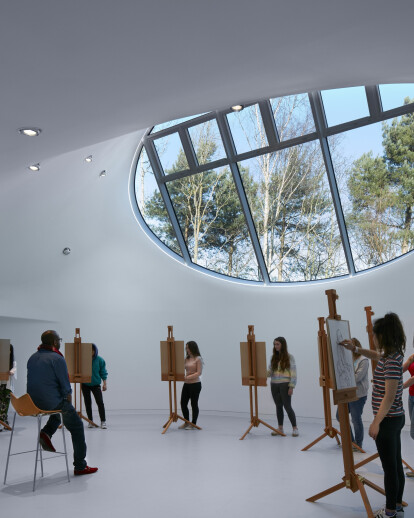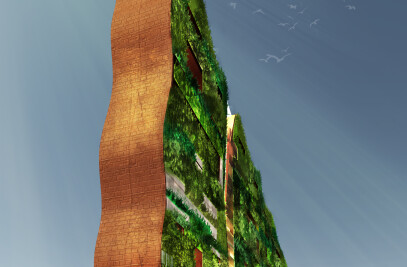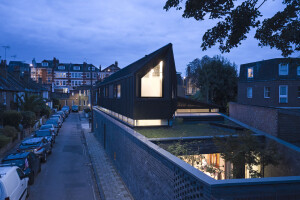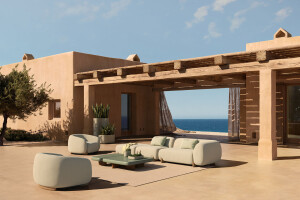A belief in the power of Drawing and its central role in artistic creativity is vociferously shared by Stuart Bartholomew, the Vice Chancellor and Head of Arts University Bournemouth and its architect alumnus, Sir Peter Cook. In 2014 Bartholomew invited Cook to design this building, which is dedicated to that pursuit. Cook’s office CRAB (the Cook-Robotham Architecture Bureau) with Jenna Al-Ali as Project Architect have then developed an instrument that is to be used by the students of all of its 17 departments. These range from painting, sculpture and Illustration, through to architecture, costume, drama, and model-making with the result becoming the first such dedicated Drawing Studio as a stand-alone structure to be built in a British art college for more than 100 years.
The Studio celebrates – and designed around - the phenomenon of natural light. Taking the form of a large room of 140 square metres . Thus it has a 30 square metre oval north-light window as main illumination, with a ‘booster’ light for the rear of the room from a clerestory window of 10 square metres. On the east side there is a further natural light source in the form of a low window located under a long bench that emanates a mysterious glow and finally, a gradated wash of natural light passes through the glass entry door and along the curved wall beyond.
The outside of the building is a totality - uniformly painted blue and serves as a ‘marker’ element for the north end of the AUB Campus. The interior is uniformly white – and thus acts as a foil to the drawing activity. Such uniformity serves to concentrate the eye upon the form and undulations of both exterior and interior.
This single entity unfolds towards a small ‘porte clochere’ that protects the actual entry door : and inspires a formally related wing for the emergency exit. Small internal zones – the toilets, service room and drawing store room are provided on the southern flank of the Studio room but are encompassed by the major sculptural form.
The external skin is a steel-sheet monocoque construction of 17 steel panels - prefabricated in the factory, transported to site and bolted as a kit of parts and then welded to form a smooth, waterproof enclosure. The internal skin has been developed through a technique of GRG (glass reinforced gypsum) that enables the exterior profile to be directly echoed within, whilst at the same time creating a useful servicing and insulation cavity.
From a very early stage, the design team of CRAB studio (architects), AKT II (structural engineers), steel shell fabricator CIG and main contractor Morgan Sindall all collaborated very closely and discussed a sequenced operation on a very small site.
Sustainability The design for the Drawing Studio incorporates a holistic approach to sustainability. The building directly faces north and has a small footprint. The massing of the building was formed around its relationship to natural light. Its form emerged by a series of physical and 3-dimensional models that revolved around the penetration of natural light into the interior.
The large windows allow maximization of the use of controlled natural daylighting so radically reducing the need for artificial lighting. The seamless monocoque also creates an airtight construction so reducing the building energy use. The building is also naturally ventilated through the use of high level clerestory windows.
The Drawing Studio responds to its natural surrounding consisting of flowing grassed mounds and a dense group of trees. The landscape scheme focused on preserving and restoring the site’s natural habitat and enhancing the existing contribution which the trees made to the campus. The project is not only a beautiful object in the natural setting, but an experiment in new geometric modelling tools, buckling analysis methods and steel fabrication techniques, which take an existing technology and, through the use of new, more sophisticated automated tools, achieve much higher levels of precision and refinement in the final form. Throughout the structural optimisation process, bespoke software tools were developed by AKT II to model the surface, allowing control over the geometry of the outer form and pattern of its internal ribs. This allowed the reduction of plate thickness of the monocoque to a minimum through detailed non-linear plate buckling analysis and optimisation of the external curved plate patterning to reduce waste and facilitate fabrication.
The development of these tools has allowed the use of the structure as an environmental envelope and finished architectural form, eliminating the need for a separate external applied cladding layer and reducing the amount of material, effort and capital invested in the project. The internal ribbing patterns of the monocoque also provided the support and setting out for the internal insulation and smooth GRG finish. The spread of the loads along the entire perimeter of the shell, rather than at discrete column positions, as in traditional steel frames, allowed the use of a shallow concrete foundation.
Innovation through the integration of building components, which are usually designed separately by different disciplines, has the potential to create more holistic, coordinated and sustainable designs in the future. This requires a first principles approach to design and the research and development of tools and technologies aimed at rationalising geometry, optimising material use and simplifying fabrication and construction with a deep engagement in the very essence of the architectural intent.


































